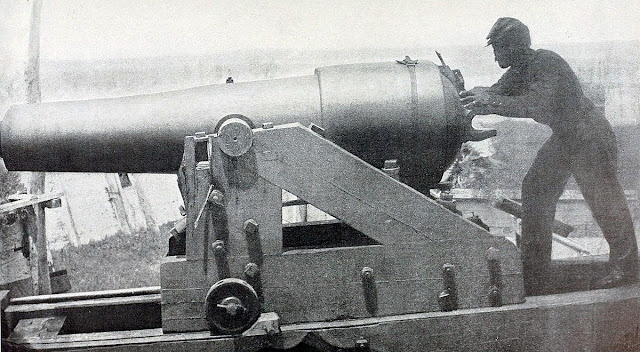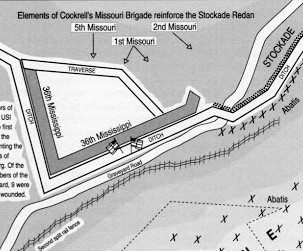Less than an hour into Wednesday, 20 May, 1863, the city of Vicksburg was rocked by a stomach churning thud, originating from the river at its feet. Explained the diary of the 3rd Louisiana regiment, “A huge iron-clad approached from below, and commenced a furious bombardment of the city, which was rapidly responded to by our heavy batteries...The hoarse bellowing of the mortars, the sharp report of rifled artillery, the scream and explosion of every variety of deadly missiles, intermingled with the incessant, sharp reports of small-arms...” And thus began the final siege of Vicksburg.
As the sun finally rose that Wednesday, 48 year old Lieutenant General John Clifford Pemberton commanded just under 20,000 men, 72 heavy guns and 103 field cannon stretched in an 8 mile “D” around the city The military adage that the defense multiplied defender forces by 3, which, according to the text books meant that Pemberton's 20,000 men should withstand 60,000 attackers. And for the previous six months, the spade and the engineer's diligence had struggled to reinforce that adage.
The river batteries formed the backbone of the “D”, from South Fort rising above Stout's Bayou to the Hill Fort, frowning down upon the DeSoto bend of the Mississippi river –
From south to north, there was The South Fort (above)...
and The Widow Blakely Battery (above), whose cannon was known as "Whistling Dick". The Marine Hospital Battery, The Brooke Battery, The Railroad Battery, The Depot Battery and the Whig Office Battery,...
...then across the Glass Bayou to Wyman's Hill Battery (above)...
...and Batteries 4 through 7, then up to the Hill Fort (above). Together these contained 37 heavy guns and 13 field cannon, manned by some 3,500 men.
That left the 6 ½ mile long landward defensive line, with 1 infantryman for every 2 feet of trench. Their weapon was the rifled muskets, with a truly effective range of 150 yards and an effective rate of fire of 3 rounds per minute. Pemberton's artillery on the land side consisted of 35 heavy guns and 90 cannon in earthen redans (V-shaped forts) and redoubts (French for 'a place of retreat'), averaging one cannon for every 250 yards, with a safe rate of fire of 1 round per minute. But the design of these fortifications had been developed over a thousand years to concentrate the defenders and cannon at critical points.
All trees up to 300 yards beyond the defenses were clear cut to provide a an unimpeded field of fire. That wood was then used in the three medieval defensive lines. First a 10 foot deep ditch was excavated, in the north above The Military Road, running ¾ of a mile eastward from the Hill Fort. Any attacker would find themselves forced into this depression directly in front of the defending gunners.
In the trenches interior wall, abatis were half buried – a felled tree or bush with the branches facing the attacker, or man made Cheval de Fris (above), to slow and disrupt an attacker. Dirt scooped from the trench was used to raise the steep rampart walls of the second and primary defense positions - a broken line of lunettes and redans, on high ground above the terminations of the numerous gullies which steams had carved through the Vicksburg loam.
In architecture, a lunette (rights) – French for little noon – is the recessed arch above a doorway. In fortifications it is a similarly shaped defense position with an open rear. A redan (center) is generally larger, some at Vicksburg had 20 foot thick earthen walls, and a single “V” rampart thrusting toward the attackers. The rear of all these positions were open except the 4 walled "Redoubt".
The objective is to force the attacker to either smash their strength against a single high point, or flow around the obstruction, dissipating their strength and offering their flanks at close range to the defending marksmen inside the fort. Should the enemy attack the undefended rear, he would then present their own rear to a counter attack from troops in the third line of trenches.
The top of the “D” was the Stockade Redan, at the eastern end of the northern line, so named because a Poplar tree stockade wall which stood across the junction of the Military and the Graveyard Roads. Defending the Stockade Redan was the 27th Louisiana and 36th Mississippi Infantry regiments, with three Missouri regiments in reserve, behind in a 7 foot deep trench line.
South of this stood Green's Redan defended by the 37th Mississippi Infantry, with the 26th Louisiana Infantry in reserve. A quarter mile further south was the 3rd Louisiana Redan, and then The Great Redoubt, so called because it was the largest fort in the Confederate line , with four rectangular earthen walls.
South of the Great Redoubt the ground in front of the line was too broken support an attack, so there was only the a mile long ditch with abatis and manned trenches behind. But then came the 2nd Texas Lunette and the Railroad Redan (above), named because the South Railroad ran through the gully, along with Potter's Chapel Road.
A quarter mile south west, as the “D” began to angle back toward its base, was The Square Fort, later named Fort Garrott after its namesake, 36 year old Colonel Isham Warren Garrott from the 20th Alabama regiment. Garrott was cut down by a sniper's bullet during the siege. A half mile further southwest, guarding the ravine where Hall's Ferry Road left Vicksburg, was the Salient Redan. The steep ravine carved by Stout's Bayou, as well as broken ground and lack of roads over the next 1 and ¾ miles made this section unsuitable for either an attack or defense. But the Vicksburg defenses were tied down with the powerful South Fort, guarding the Warrenton Road.
With the arrival of dawn, Wednesday, 20 May, Grant's artillery joined the bombardment from the river. According to the 3rd Louisiana diary, “The place was a perfect pandemonium...The hoarse bellowing of the mortars, the sharp report of rifled artillery, the scream and explosion of every variety of deadly missiles, intermingled with the incessant, sharp reports of small-arms, made up a combination of sounds not such as described by the poet as being a " sweet concord."





















































No comments:
Post a Comment
Please share your reaction.